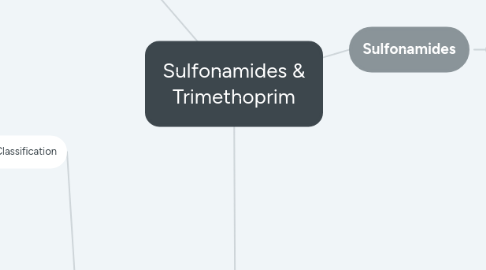
1. Trimethoprim
1.1. MOA
1.1.1. Binds to dihydrofolate reductase & inhibits reduction of dihydrofolic acid (DHF) to tetrahydrofolic acid (THF).
1.1.2. Inhibits bacterial DNA synthesis
1.2. Pharmacokinetics
1.2.1. weak base, higher concentration achieved in prostatic and vaginal fluids
1.2.2. undergoes O-demethylation
1.2.3. 60-80% renally excreted unchanged
1.3. Clinical uses
1.3.1. given orally - acute urinary tract infections
1.3.2. susceptible to many community-acquired organisms in urine
1.4. Adverse efffects
1.4.1. Leucopenia
1.4.2. Megaloblastic anaemia
1.4.3. Pancytopenia
1.4.4. Hyperkalemia
2. Cotrimoxazole
2.1. Drug Classification
2.1.1. Consist of 2 antibiotics which is Sulfamethoxazole and Trimethoprim called sulfonamides
2.2. MOA
2.2.1. Trimethoprim is a direct competitor of the enzyme dihydrofolate reductase, causing its inhibition, which halts the production of tetrahydrofolate to its active form of folate.
2.2.2. Sulfamethoxazole achieves this directly as a competitor of p-aminobenzoic acid (PABA) during the synthesis of dihydrofolate via inhibition of the enzyme dihydropteroate synthase.
2.2.3. Thus, co-trimoxazole block two steps in the bacterial biosynthesis of essential nucleic acids and proteins, thus can be bactericidal.
2.3. Pharmacokinetics
2.3.1. Trimetheprim in Cotrimoxazole concentrates in relatively acidic environment of prostatic fluid, which accounts for its use in the treatment of prostatitis
2.3.2. readily crosses the blood brain barrier
2.3.3. both parent drugs and metabolites are excreted in the urine
2.4. Clinical uses
2.4.1. uncomplicated lower urinary tract infection
2.4.2. respiratory tract infection
2.4.3. typhoid fever
2.4.4. bacterial diarrhoea
2.4.5. pneumocystic jiroveci
2.4.6. chancroid
2.5. Adverse effects
2.5.1. nausea, vomiting, stomatitis, rash
2.5.2. folate deficiency- megaloblastic anaemia
2.5.3. blood dyscrasias (occurs rarely)
2.5.4. bone marrow toxicity (mostly in elderly)
3. Sulfonamides
3.1. Drug Classification
3.1.1. Systemic
3.1.1.1. Long acting- Sulfadoxine
3.1.1.2. Intermediate acting- Sulfadiazine, sulfamethoxazole
3.1.1.3. Short acting-Sulfisoxazole
3.1.2. Topical agents- Sulfaacetamide
3.1.3. GIT- Sulfasalazine
3.2. MOA
3.2.1. Are competitive inhibitors of dihydropteroate synthetase (enzyme important for synthesis of THF)
3.2.2. Tetrahydrofolate important for pyrimidine nucleic acid synthesis
3.2.3. Have bacteriostatic effect not bactericidal
3.3. Clinical uses
3.3.1. Sulfadiazine (intermediate acting) – Nocardia spp. infections
3.3.2. Sulfacetamide (topical agent)— skin infections and eye infections
3.3.3. Sulfisoxazole (short acting)– Urinary tract infection
3.3.4. Sulfasalazine (GIT) – Ulcerative colitis and rheumatoid arthritis
3.4. Adverse effects
3.4.1. Crystalluria
3.4.2. Hypersensitivity
3.4.3. Hemolytic anemia (G6PD deficiency)
3.4.4. Kernicterus in newborn
